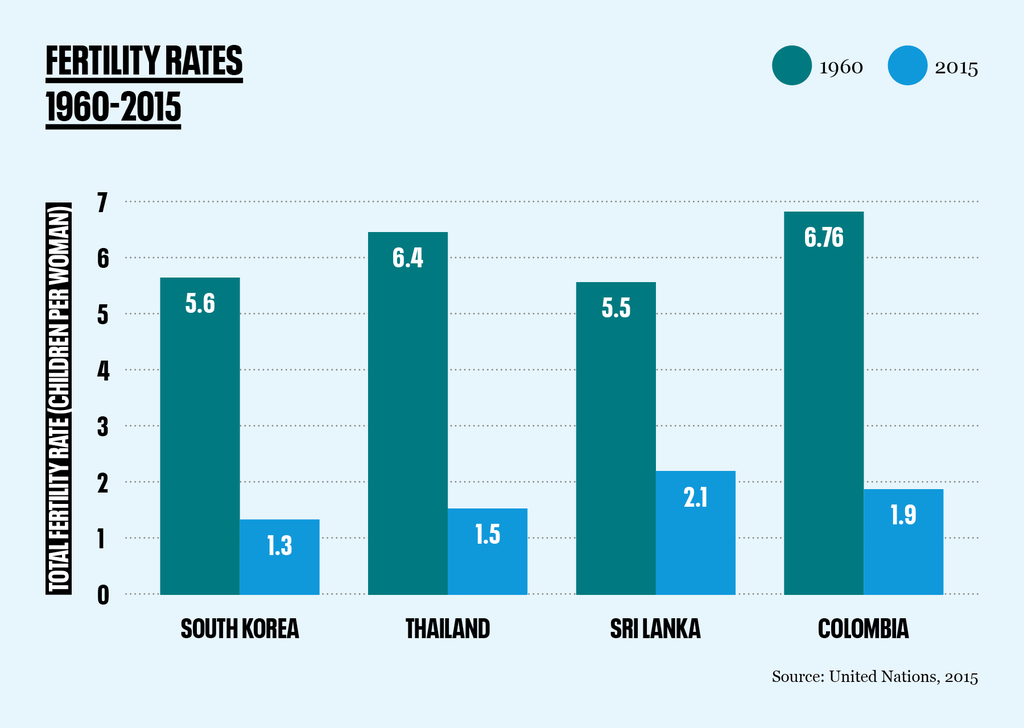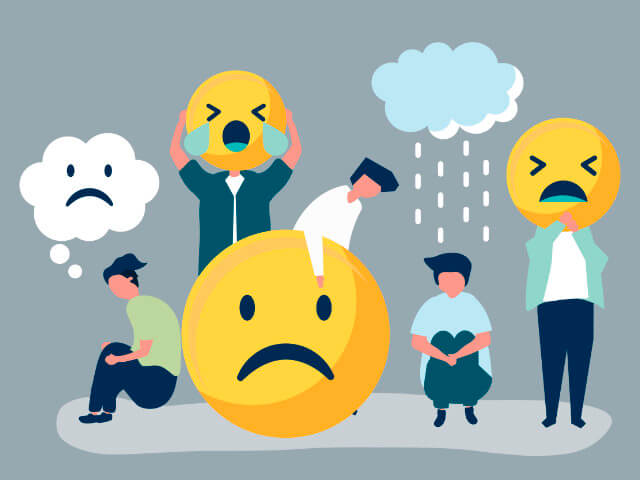Looking ahead
Young people wonder how the future will look different because of climate change.
Theme Questions
Your question is very important to answer. I want to answer it because I have been interested in and worked on managing the interaction of people with the Earth for as long as I can remember. At your age, I was asking what the world was like before people and what difference we have made, good and bad. What a tough question. And 1.5 degrees does not seem like much, does it? Your question is so important that the Intergovernmental Panel on Climate Change (IPCC) devoted a whole special report of 630 pages in 2018 to this question. The answer I give is only a snippet of what you might wish to learn.
What does it mean to have a 1.5 degree Celsius temperature rise? This means that the average surface temperature (across all land, sea, and ice) of the Earth will have risen by 1.5 degrees since pre-industrial times. Pre-industrial times were times when the impacts people had on the Earth were very small and local to where they lived.
Because this is the average whole-Earth-surface temperature increase, the increase in average temperature will be different in different places – hot, dry areas will become hotter and drier. Cool, wet areas will become warmer and may either become drier or wetter depending on where they are. Frozen areas will become ice-free. The tropics will become places difficult to live in, for people, animals, and plants. The polar environments will reduce and may disappear in some places. This is happening now with the bleaching of coral reefs, the burning of rainforests, the drying of the continents and the reduction of ice-dependent systems, particularly in the Arctic and in the highest mountain ranges. And the sea level is rising. Thus, an average increase of the Earth’s temperature even before we reach 1.5 degrees can have wide ranging effects because of this variation around the Earth.
According to the IPCC, the Earth will not be doomed when the average temperature of the Earth goes past 1.5 degrees but, increasingly, life will become very different to what we are used to and, for many people, animals and plants, it will become very much harder to live (thousands of species are expected to go extinct as a result and many people will die). Our dreams and stories about life on the Earth will more and more become memories of past days rather than opportunities for experiencing in the future. But why would that be?
There are two very important factors to consider. The first is how rapidly and how far the sea level will rise. In Tasmania, many low-lying areas with townships (e.g. Kingston Beach) will become more frequently flooded, to the point when insurance companies will no longer insure houses for damage. Who will pay for those people to move their homes? Where will they go? More significantly, many low lying countries will become uninhabitable because of sea-level rise and floods. The people from those countries will need to move. How many millions of people will that be? Where will they go? Will they be helped to relocate? How understanding will the world be to people forced out of their homes?
The second factor is what a warmer atmosphere and ocean will do? Communities and livelihoods built on or around ice (permafrost, glaciers, snow) will reduce and possibly disappear. The IPCC has well established that the frequency and intensity of extreme weather events will increase. Increased storms and floods will compound the impacts of sea level rise as well as disrupt ports, coastal airstrips, roads, electricity grids and so on. But it is not just about storms and floods, it is also about heat waves and droughts. Hotter and longer heat waves will result in more people dying from heat stress. Longer and more frequent droughts will mean farms, grasslands and forests will become much drier and more difficult to sustain. This will lead to starvation and lack of water in many communities. In Australia, our Great Artesian Basin that gives water to so many of our rural communities will begin to dry up. Some of the more sensitive areas will be lost, like the Great Barrier Reef.
Limiting warming to 1.5 degrees will give us a greater chance of restoring the world to what we know and love. The greater the Earth warms the longer the impacts of that warming will last – rather than the effects of warming remaining until the end of the century it is likely to remain long after that time. Many scientists fear that if the Earth warms beyond 2 degrees then it may reach tipping points from which we cannot return to what we know. How can we believe this will happen when we have not experienced these levels of warming? The IPCC has well established mathematical models able to assess the nature of the climate, weather and state of the physical Earth system. These models have been tested in many ways to ensure they can be validly used to assess what the world will be like. These models then are used to determine what might happen to farms, forests, cities and ocean systems. For Tasmania, this has been done in a Climate Futures Tasmania project, which was one of the first projects globally to undertake these kinds of assessments to help communities and governments better plan and adapt to the future.
Can you believe these results? Ask your parents or grandparents how reliable the weather forecasts were during their childhood. Compare that to the forecasts we have now when we can plan at least four days in advance for what the weather will be like. These forecasts are based on atmospheric models, the same kind of models used for climate assessments.
The short answer is no. However, reefs will change from how we know them today. When considering reefs, the two major types of reef in Australia are tropical coral reefs and temperate rocky reefs, home to kelp forests. Both these reef systems are sensitive to ocean warming and marine heatwaves and both have experienced extreme impacts in the past decade. For example, almost 100,000 Hectares, equivalent to 2.3 million basketball courts of kelp forests were lost in Western Australia in 2011 following an extreme marine heatwave. In the tropics, marine heatwaves in 2016 and 2017 resulted in severe coral bleaching and death on the Great Barrier Reef.
As oceans warm, these extreme events will become more frequent and species that are already living close to their upper thermal limits are likely to suffer. In Australia, species on both coral reefs and kelp forests have evolved for millions of years under remarkably stable climate conditions. Unlike on land where temperatures can fluctuate by over 30ºC in a year, in the oceans around Australia, temperatures may only fluctuate by 5-10ºC. As a consequence, many species have limited scope to deal with changes in temperature. On top of this, south-eastern and south-western Australia are warming 2-4 times faster than average, making these regions particularly vulnerable to change.
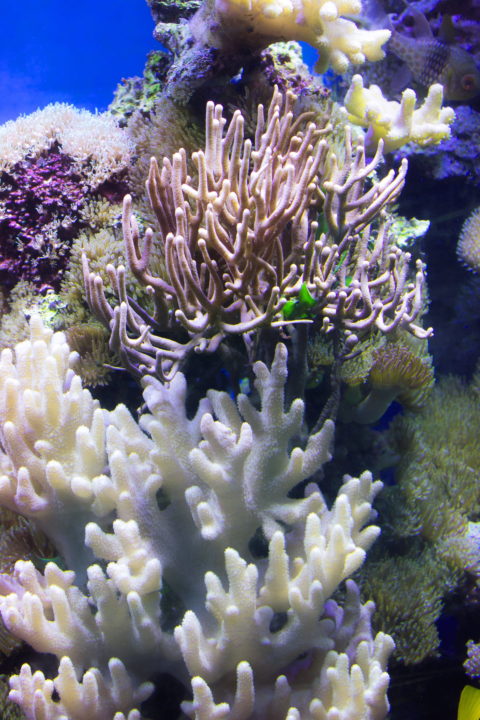
In response to changing ocean conditions, species can either move to cooler habitats, adapt, or die. Many species are unable to move or adapt fast enough to escape the warming, or the impacts of a sudden marine heat wave. For the species that can move elsewhere, they may be able to survive in their new habitat, but in doing so may be lost from the reefs they have departed. As a result, there will be a change in the types of species that we see on reefs, with increasing numbers of warm water species in places like Tasmania, and a loss of the traditional cool-water species. Giant kelp is one example of this, which has decreased by 95% on Tasmanian reefs in recent decades. Even in the tropics, many heat tolerant species will survive, but it might not be all the colourful corals and fishes that we think of today.
What an excellent and timely question: there has been a lot of discussion about nuclear power in the media recently. Also, Australia’s new plan to get to net zero emissions by 2050 does not rule out including nuclear power in this country’s future energy mix. So it’s an important time to be thinking and talking about nuclear.
Nuclear energy is used to generate electricity in 30 countries around the world, and provides about a tenth of the world’s energy needs. Nuclear power needs uranium, and the planet has uranium resources sufficient to fuel existing demand for more than 130 years. Nuclear power does not cause direct greenhouse gas emissions, which is good when we are thinking about climate change, however, the waste from nuclear power generation is problematic. It remains radioactive potentially for thousands of years and needs to be carefully stored under very controlled conditions in order not to pose a danger to humans and the environment.
Could Australia develop nuclear power? Currently the answer is no. That’s because Australian law currently prohibits the approval and construction of nuclear power plants and the enrichment of uranium needed for nuclear power. Could Australia develop nuclear power in the future as part of an effort to reduce greenhouse gas emissions? Australia does have a lot of uranium, in fact, it supplies about one third of the total world demand for uranium.
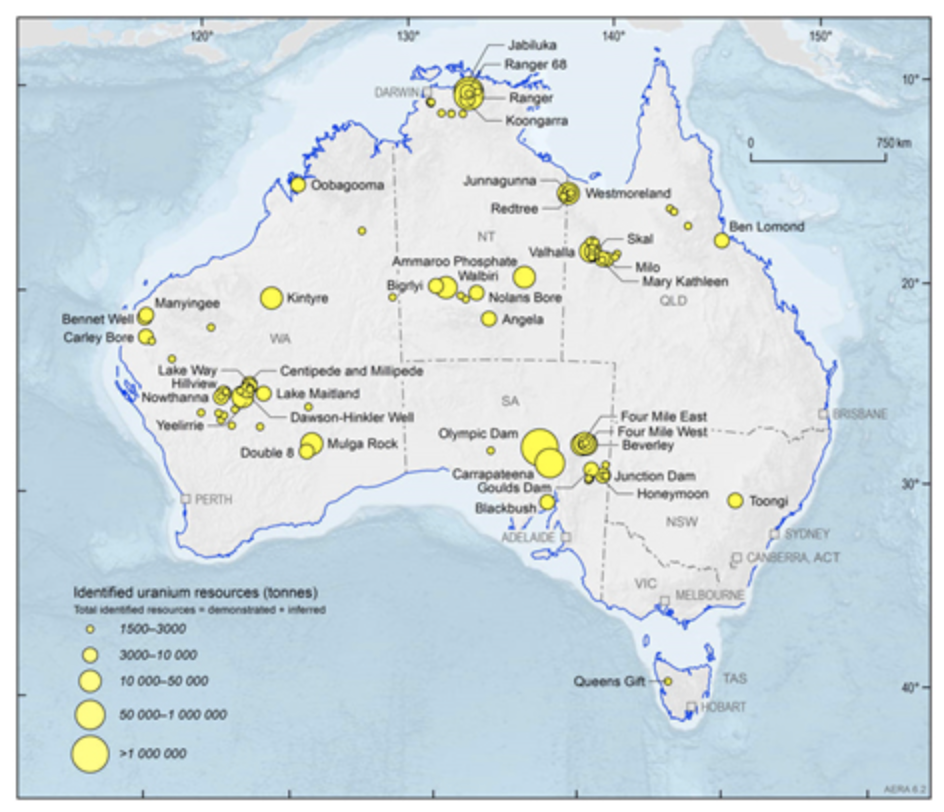
The problem with nuclear for Australia as part of the effort to reduce emissions this decade is quite simple: it’s too slow, and too expensive.
How is it too slow? The timeframe to build a nuclear power station is at least 10-12 years. If we started to build a nuclear power capacity in Australia right now (and remember, the law currently prohibits it) it would not be operational until the early-mid 2030s. Science tells us we need to cut emissions right now, this decade.
How is it too expensive? Despite our domestic reserves of uranium, nuclear is by far the most costly energy for Australia to generate, as you can see from the illustration below.

Comparison of power generation technology cost estimates. Source: CSIRO Gen Cost 2019-2020
If we were to build nuclear power capacity in Australia, starting today, the cost of renewables like wind and solar would be much less even than it is today by the time we were able to generate any nuclear power.
So we might pursue building nuclear power in Australia if we had no other alternatives, but we are lucky to have some of the most plentiful solar, wind and particularly offshore wind resources in the world. So renewables like wind and solar, backed up by hydroelectricity, batteries, and new fuels like green hydrogen, will be a faster and cheaper way to decarbonise than turning to nuclear power.
This is an excellent question and there are many possible answers. As you know, climate change itself can be described as a “wicked problem” for which there is no one “correct” solution.
It’s certainly possible to switch power sources from fossil fuels to renewable energy – especially wind and solar – and with the right incentives and policy from government. Importantly, we can do so quite quickly which is exactly what is now needed. We can do this both on a small scale (eg: solar panels on rooftops) to a larger scale (eg: vast solar and wind farms). In Australia, we are particularly lucky to have excellent conditions for generating renewable power: plenty of sun and wind, and space for solar and wind farms.
We can also use wind and solar, and also existing hydroelectric energy generation, to help manufacture what’s known as “green” hydrogen as an emissions-free fuel. Making hydrogen needs lots of electricity, but if we use electricity from fossil fuels in this process, we don’t cut carbon dioxide emissions enough. Creating a green hydrogen industry is a really exciting opportunity, especially for Tasmania, as we may be able to export hydrogen to replace fossil fuels in manufacturing and heavy transport industry. For example, it’s currently being used in mining trucks instead of diesel. Take a look at this short video to help you understand more about green hydrogen.
You asked about side effects. One very positive side effect is that switching from fossil fuels to renewables will actually create jobs in Australia. Renewable energy could employ as many as 44,000 Australian workers by 2025. Of course, people who currently work in the fossil fuels industries would need to transition jobs, and this would need to be done in such a way that is fair to those workers. Some reports forecast that there could be 250,000 additional jobs in Australia by 2070 if the transition to a renewable economy is managed well.
Another positive side effect of moving away from fossil fuels will be cleaner air. Burning fossil fuels produces carbon dioxide, which is bad for the climate, but also produces pollutants such as sulphur dioxide, nitrogen dioxide and very fine particles which can play havoc with our respiratory and cardiovascular systems. A recent study showed that Australia could save $6 billion a year on health costs if we stopped burning fossil fuels.
In terms of negative side effects, one important one is that our transition to a renewable energy future will still have significant environmental impacts. Vast wind turbines need huge amounts of steel and copper, solar panels need rare earth minerals and batteries need lithium. All of these need to be mined from the earth, often with extremely damaging environmental consequences and impacts on biodiversity. So we need to remember that all consumption, even renewable energy consumption, has an impact on our planet. If we can consume less – particularly those of us in developed countries – and move towards a circular economy where what we extract from the earth is used and re-used, our transition to a decarbonised world will also mean a healthier and fairer environment for all.
Tasmania is one of the marine global warming hotspots, which is big a challenge but also a potential opportunity for the Tasmanian fishing industry. Some important Tasmanian fisheries species might become less abundant and more vulnerable to climate extremes, but other species might benefit from warmer ocean and increase in abundance. Some fish species that are moving into Tasmanian waters already are or could become valuable fisheries species. The fishing industry can be sustainable if it adapts proactively, plans for the future and also supports marine protected areas to help improve resilience of fish populations. Actually, the Tasmanian fisheries industry is one of the few in the world that have conducted risk assessments, to see how climate change might affect them, and have already started some important adaptations (like actively fishing for a pesky urchin that has moved into Tasmania now that it is warm enough for it survive, but the urchin creates a problem by eating all the kelp habitat that lobsters need!).
One of the big questions for Tasmanian fisheries is how climate change will affect giant kelp forests. These forests are very important for fish and fisheries but are threatened by rising sea temperatures and the increasing sea urchin populations. Together with other management and fishing changes, marine protected areas could play an important role, as they help to rebuild the numbers of large fish and lobsters, which in turn keep the urchin numbers down.
You could read more about climate change adaptation research here.
Thank you for this excellent question. I am not an expert in genetics and don’t believe that there is currently any evidence of true genetic adaptation to climate change. Authors such as Donna Harraway have speculated about this in works that use writing styles similar to science fiction (e.g her book “Staying with the Trouble”). However at the moment works like this are “thought experiments” which imagine what genetic adaptation might be like, rather than science based on genetic evidence.
There are many other ways that human societies are starting to adapt to our changing climates. Some of this change involves large-scale changes to the way societies live every day, e.g changing our power and transport systems to renewable energy rather than systems reliant on fossil fuels. For example, it’s no mean feat to change our current transport systems from petrol cars to predominantly electric vehicles. However, countries like Aotearoa New Zealand are currently preparing their infrastructure to do just that. This is an example of large-scale adaptation.
In terms of our bodies dealing with extremes in temperature (e.g hotter summers), there are limits to how our bodies can deal with this and still maintain a healthy core temperature. For example if we live in hotter, more humid conditions (e.g higher than 33 degrees Celsius), we would need to be careful to avoid heat exhaustion by drinking more fluids and being careful what time of the day we exert ourselves. Many people in the world already live in very hot places, and generally their housing and lifestyles reflect sensible ways to live in these conditions. It’s possible that some of these ways of life will become more common in other parts of the world if the weather is consistently warmer.
Climate change is absolutely will mean that many jobs will be changing into the future. We have already seen big changes in the jobs available due to climate change. Some of these changes offer new opportunities. For example, there are more jobs in renewable energy - the renewable energy sector currently employs about 26,000 people in Australia. Tasmania has jobs in hydro and wind electricity generation, and potentially in a new green hydrogen production industry. The future of jobs in this sector however depends on policy decisions made at the moment.
Some existing jobs have also changed due to climate change. This includes jobs in agriculture, manufacturing, and construction. Many of these jobs will still be a part of our society going forward, but they will probably look different than they have previously. We’ve also seen a shifts in law, with environmental law becoming a specialty area, and changes in social work as greater focus is being placed on disaster response. There are also opportunities for jobs as climate change educators and science communicators. As well as jobs in creating resilient communities, and disaster preparedness.
Climate change will also present some challenges to jobs in the future. Extreme weather events are likely to have impacts on working conditions and safety.
At the moment in particular we want to be encouraging decision makers to be considering the future of climate change as they make policy decisions. You may also like to think about what you’re passionate about, what your talents and skills are and how you could contribute to climate change as you think about what job you’d like to do in the future. What brings you joy and how can you use that to help respond to climate change.
There are 2 polar icecaps, Antarctica and Greenland, and if all the ice they held was melted into the ocean then the sea level would rise more than 60m, enough to cover most of Hobart. Don’t worry though. Even if that were to happen (and no serious scientist thinks it will), it would take hundreds of years for all of that ice to melt.

A much harder question to answer is how much of the polar icecaps are likely to melt, and what will happen then? Since 2006 global sea level has risen about 48 mm, about 22% from Greenland melt and 13% from Antarctica. Although Greenland is melting faster at the moment, there is much more ice in Antarctica, and in fact understanding how much Antarctic ice will melt in the future is one of the biggest questions in climate science. As well as increasing the size of the ocean, adding all that fresh (non-salty) water may change the way that the ocean
currents move water between the surface and deep ocean, which could impact sea life and the rest of the climate.
Scientists are working hard to better understand how the icecap will change in the future, both by visiting Antarctica to take measurements, and by building better computer models. In the meantime, it’s important that we take action to limit warming in Antarctica as much as possible.
Climate change and its causes will affect your generation in many different ways, in Australia and elsewhere. These include rising average temperatures, more frequent and severe storms, floods and bushfires, and extinction of plants and animals. The loss of topsoil from drought, flood and wind and unpredictable weather will affect farming and could cause more frequent and severe famines. This could lead to increasing political tensions in some countries around access to resources. People and governments will need to spend more money on safety and preparedness. These impacts are all related to one another.
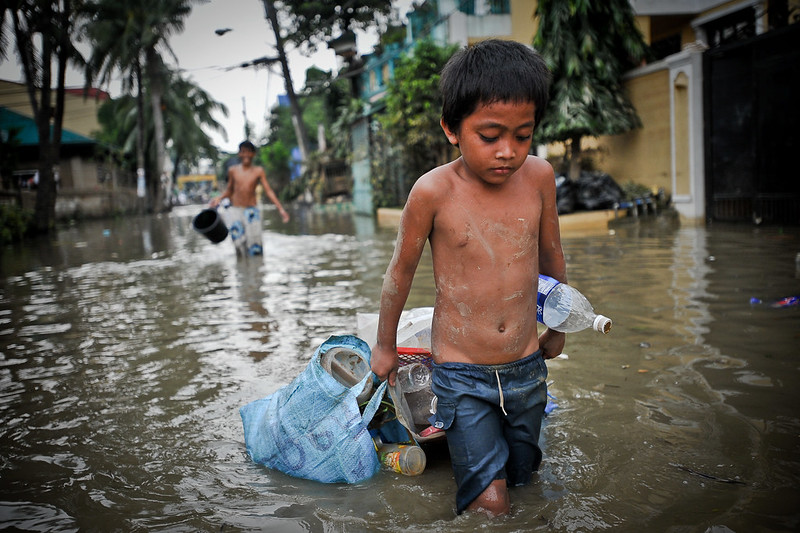
A lot of produce will become more expensive as environments change. This includes coffee and honey, and even some vegetables, fruits and meat. Campfires, burn-offs and open-flame barbeques would be restricted for longer parts of the year as fire bans become increasingly common. Take the example of the 2020 bushfires. More than 3 billion animals were impacted, forests were damaged or destroyed, and human tragedies included loss of life, health, homes and livelihoods. Crises like this would be repeated in increasingly worse fire seasons, meaning bigger and bigger expenses for fire preparedness. Taking action on climate change will not stop these impacts entirely, but it can reduce them.
Climate change and its causes impact more than the natural environment. They have knock-on impacts in health. Air, water and soil pollution will continue to cause health conditions and worsen existing ones like cardiovascular and respiratory diseases as well as cancers. While these outcomes are less common in Australia, they happen here too. People in poorer communities with fewer support structures are impacted most. Your generation will see these impacts in your lifetimes. In fact, you already have. Increased exposure to new infectious diseases in the environment has also been linked with climate change, meaning epidemics and pandemics may be a thing of the future and not just the present.
While these impacts cannot be stopped completely, there is so much that can be done to avoid the worst of it. If we rapidly reduce the greenhouse gas we emit, we can improve the future for your generation and the generations who follow you. Action on climate change now will play an important part in your future quality of life, and in the lives of many others around the world in your lifetime.
In the last 2,000 years the human population has increased by 7,510,000,000 (more than seven and a half billion) with the last 100 years (since 1900) seeing an increase of more than six billion people (Figure 1). Rates are starting to slow, but there will still be more than a billion more people in the next decade. Earth systems have limits, many of which are already being stressed due in no small part to an increasing global population. However, increasing population is only one part of the puzzle, we also need to look at consumption.
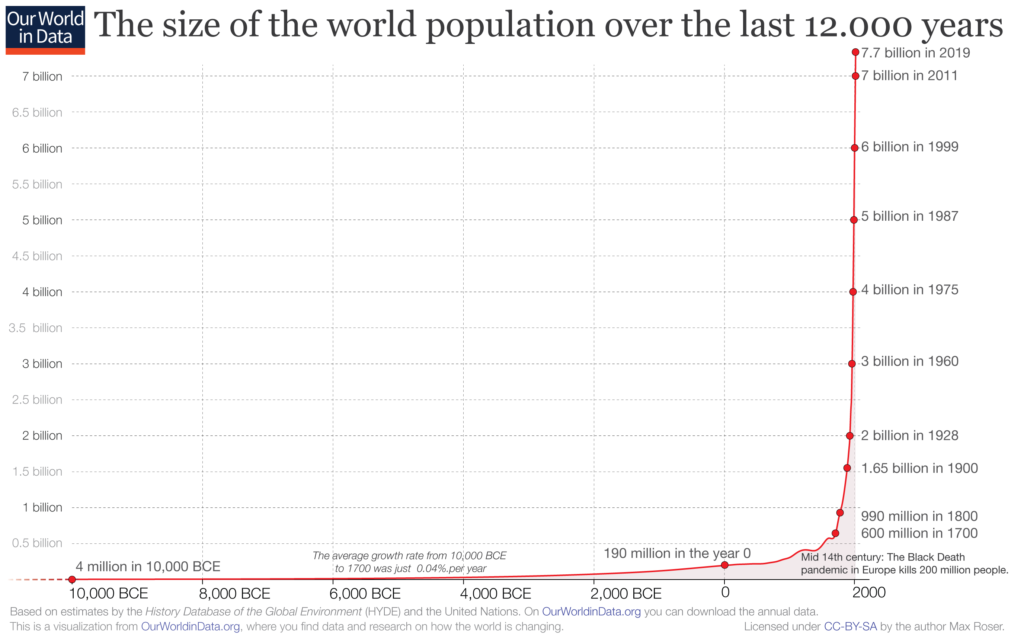
The size of the world population over the last 12,000 years. Source: Our World in Data.
One way to think about consumption is to consider what you ate today, how often you travelled in a car, and how much stuff you bought. Monitor that every day for an entire year, add it all up, and you get your personal rate of consumption. If you do that for everyone in Australia and divide it by the country’s population, we can get an average consumption rate, also called consumption per capita. Now here is where things get tricky. If all 7.7 billion people on the planet consumed resources at the same rate as Australia, we would need almost five Earths worth of resources. Fortunately, not every country consumes as much as we do, but most countries consume far above the planetary limits, despite all our advances in agriculture, new energy saving technologies, and changes in lifestyles. And collectively, the whole world is already consuming 1.7 Earths, which would only get worse with more people on the planet.
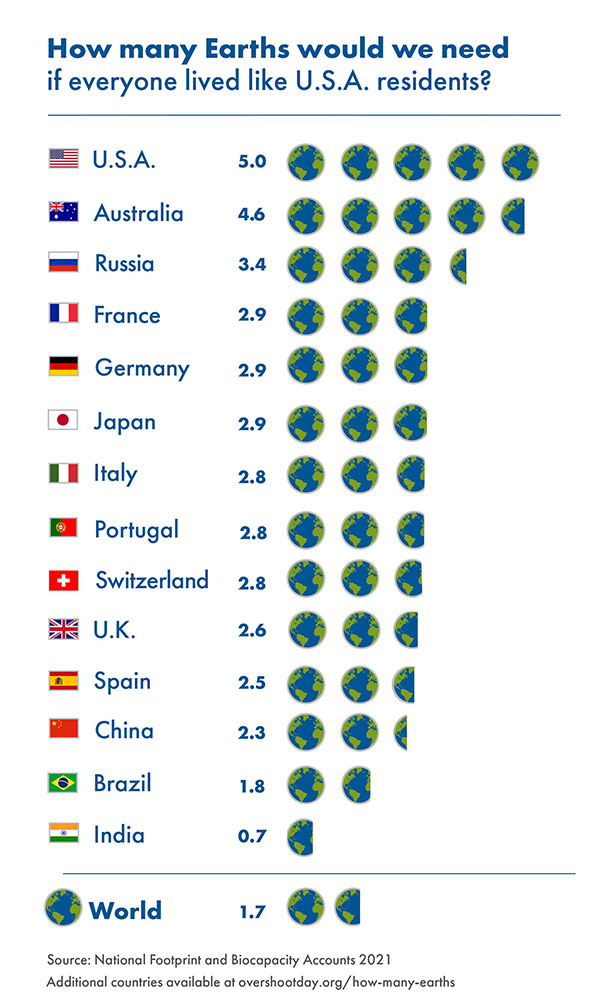
So with the global population still increasing and our consumption rates being wholly unsustainable, what can we do? China, in an attempt to reduce its population, implemented the One Child Policy from 1979-2015, which, while reducing the population, has resulted in a lot of unintended consequences that will cause serious problems in the coming years. Alternatively, countries like Japan, New Zealand, and other high-income countries are having fewer children born every year. But that transition can take a long time and usually requires increasing rates of consumption before getting there. One of the most successful ways to reduce populations is investing resources into female empowerment and pro-active family planning. For example, South Korea saw a major drop in the number of children being born between 1960 and 2015, due in large part to improved women’s rights. While those investments are the most ethical way to reduce the Earth’s population, we need to spend even more time working on ways to reduce our massive consumption rates.
